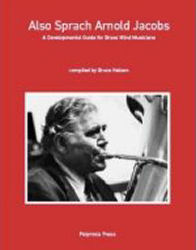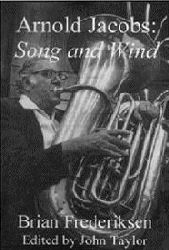Description
Here’s what they are saying – reviews of Also Sprach Arnold Jacobs
From ITEA JOURNAL:
Also Sprach Arnold Jacobs: A Developmental Guide for Brass Wind Musicians
compiled by Bruce Nelson. Polymnia Press. 2006. 104 pp.
When M. Dee Stewart’s book Arnold Jacobs: The Legacy of a Master came out twenty years ago, there was much excitement over the publication of a book concerning the greatest brass teacher this country has ever seen. The excitement was somewhat tempered when we realized that, valuable though the book is, it was primarily reminiscences of Mr. Jacobs rather than an explication of his methods and his teaching. Brian Frederiksen’s Song and Wind took a big step in that direction, but now with Bruce Nelson’s book, we finally have, mostly in Mr. Jacob’s own words, a printed version of Mr. Jacobs’ teaching.
This is not a book to read curled up in front of the fireplace. It is not narrative in style. Mr. Nelson, formerly the bass trombonist in the Lyric Opera of Chicago and the Grant Park Symphony, has scoured tapes of Mr. Jacobs’ master classes and his own lessons with Mr. Jacobs to lay out the master’s philosophy and application of teaching brass playing in his own words. Finishing a paragraph, you find yourself thinking about earlier statements, and trying to synthesize them in your mind. At times, it’s like some of those “business stores” in the mall, selling framed versions of platitudes like “Whether you think you can, or think you can’t – you’re right”. These are more than platitudes, though, and some are in boldface, such as my favorite: Breathe to expand: don’t expand to breathe. I was lucky enough in the 1970s and 80s to spend ten years studying with Mr. Jacobs, and with every sentence in this book, I actually could actually hear his voice intoning these words.
There are six chapters, with headings of “Concepts Fundamental to Development”, “Mental Controls”, “The Vibrating Embouchure”, “Breathing”, “Articulating” and “Practicing and Performing”. There is, of course, overlap in materials, but that is hardly a problem. A salient feature of Mr. Jacobs’ teaching was to repeat concepts in slightly different ways, knowing that surely one of those ways would get through even the thickest of skulls (yours truly). There are also two appendices, one a reprint of part of Mr. Frederiksen’s Song and Wind dealing with the use of breathing devices, and the other a reprint of the exercises that Mr. Jacobs wrote for publication in the Hal Leonard Advanced Band Method for Tuba. This is one of the very few items that Mr. Jacobs published, and its inclusion here, although the method book is still available, adds to the value of this volume.
All in all, Mr. Nelson is to be thanked for his achievement. Mr. Jacobs’ thoughts are finally accessible in printed reference form, and whether you are a teacher or a student, you must own this book. It is one that you will rely on for years to come.
Michael Short Senior Teaching Artist of Low Brass Drake University Des Moines, IA
FROM INTERNATIONAL TROMBONE ASSOCIATION JOURNAL:
Also Sprach Arnold Jacobs: A Developmental Guide for Brass Wind Musicians.
Mindelheim, Germany: Polymnia Press, 2006. 104 pages with index.
Those of us who learned to play brass instruments in the latter half of the 20th century are familiar with the ground breaking pedagogy of Arnold Jacobs (1915-1988), tubist of the Chicago Symphony (1944-1988). His thorough study of human physiology and psychology combined with great musicianship and the objective pursuit of the actual processes at work in brass playing set the gold standard for brass pedagogy. But since his death new generations of brass players enjoy less connection to his influence because Mr. Jacobs did not believe in putting his teachings in print, instead preferring to pass them on through direct lessons, master classes and clinics. To be sure, his influence is passed on through his student’s teaching. But also, through publications like this, Mr. Jacob’s students share his direct teachings and philosophies in festschrift-like tributes to his legacy.
Bruce Nelson, retired bass trombonist of the Lyric Opera of Chicago, studied over many years with Mr. Jacobs. He assembled this book at the suggestion of trombonist Gerhard Wolf as a “comprehensive, organized and authentic version of Arnold Jacob’s teachings.” Mr. Nelson takes direct quotes from master classes, private lessons and conversations and arranges them by topic: Concepts Fundamental to Development, Mental Controls, The Vibrating Embouchure, Breathing, Articulating, Practicing and Performing. Several of Mr. Jacob’s famous aphorisms serve as the basis for further subdivision of these topics (chapters): “By studying sound, you are studying breath.” “The tongue makes no sound.” “Order air as external wind, not as internal pressure.”
Consequently, Also Sprach is not fast food. This is the richest cuisine on the menu, the sort of material best taken in small quantities and that takes time to digest. There is so much to consider in each paragraph. Most emerging brass players, who have oblique experience with Mr. Jacobs’ concepts, will find a text that fills in the blanks, completes partial understanding, integrates concepts together, and draws verifiable conclusions about best practices. Bruce Nelson’s decisions about how to organize this material are both helpful and important. It is easy to get lost in all the profundity here; what a refreshing problem to encounter in modern literature. By categorizing the quotes, something he is uniquely qualified to do, he creates context and helps us understand what Mr. Jacobs really means. As should be expected in a collection of quotes spanning a lifetime there is much redundancy. But far from a pejorative feature this redundancy serves to pursue concepts to completion, to present core philosophies in different ways. Here are several statements taken from different chapters that, in their own contexts, exemplify the core philosophy of ‘music over method:’
“Develop good habits; don’t try to correct bad habits.”
“Embouchure is resultant, not causative.”
“Focus on the psychology, not the mechanics of breathing.”
“Base the concept of vibrato on product, not methodology.”
“Move artistic goals to the foreground.”
It took Bruce Nelson three years to compile and organize this extraordinary collection of wisdom, but it took him a lifetime of study and endeavor with one of the world’s greatest professors of the art to come to a place where this book could be written. We often grace valued publications with statements like ‘should be in every brass player’s library’ or ‘a must read.’ Also Sprach may define this category. It is a preeminent document on several fronts. The pedagogy is unsurpassed, the organization communicates this, and it is comprehensive even including the few pages of ‘Special Studies’ Mr. Jacobs did publish in 1963. We owe a great debt of gratitude to Bruce Nelson and Polymnia Press for preserving to us the teaching of one of the finest brass pedagogues of all time.
Mike Hall – Old Dominion University



